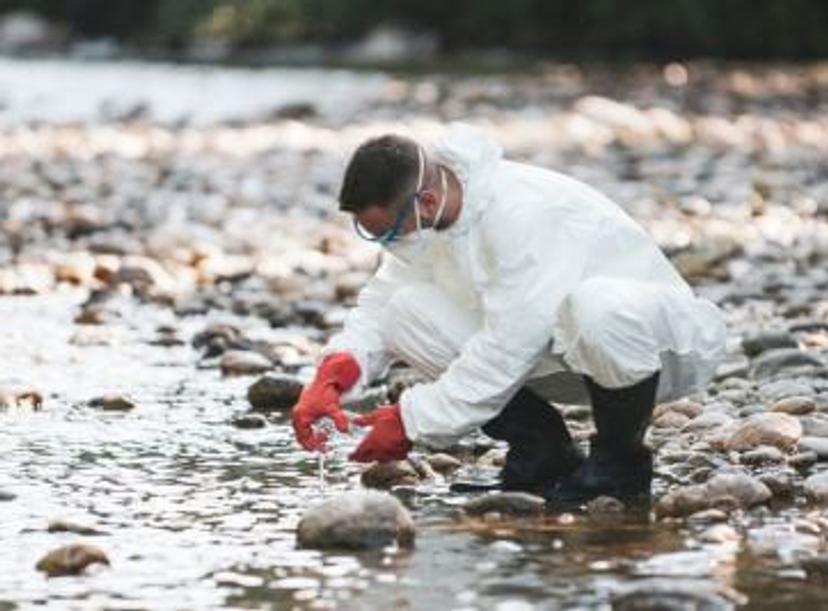Tackling the PFAS challenge
Explore the uncertainty surrounding PFAS, their profound health and environmental impacts, and the ongoing challenges in establishing effective cleanup strategies
2 Jul 2024

PFAS, or per- and polyfluoroalkyl substances, are a group of man-made chemicals used in various industrial and consumer products for their water- and grease-resistant properties.
There is plenty we do not know about PFAS, including their full health and environmental impacts. How we will clean them up is also unclear. However, with increased regulatory, scientific, and public scrutiny, we are beginning to address the problem for the first time.
PFAS ubiquity and toxicity
Dubbed ‘forever chemicals’ because their enormously strong carbon-fluorine bonds can resist degradation indefinitely, PFAS have become so ubiquitous as to be detected in the liver of an Arctic polar bear and in the blood of almost 99% of Americans1. In the US, researchers requiring blood samples uncontaminated with PFAS reportedly had to resort to 10 vials taken from soldiers between 1948 and 19512.
The chemicals’ non-stick, grease- and water-repellent properties have made them useful in a range of manufacturing applications from the 1940s to the present day – including non-stick pans, food packaging materials, paints, carpets, cleaning products, and firefighting foams. Yet the same characteristics also make them extremely mobile – able to ‘slide’ away from their original products in locations like landfills, and into the wider environment. Then, because they are absorbed more quickly than they can be excreted, PFAS bioaccumulate in water, plants, wildlife, and humans – bringing with them severe health consequences.
The World Health Organization's International Agency for Research on Cancer (IARC) recently published detailed evaluations showing that the PFAS substances perfluorooctanoic acid (PFOA) and perfluorooctanesulfonic acid (PFOS) were ‘carcinogenic to humans’ and ‘possibly carcinogenic’, respectively3. The former director of the US National Institute for Environmental Health Sciences, Linda Birnbaum, adds, “there are now hundreds of epidemiology studies showing (PFAS') association with a wide variety of (health) effects4, including cancer, liver effects, kidney effects, effects on development and reproduction, and type 2 diabetes. The more you look, the more you begin to find associations with this very broad class of chemicals”.
Facing the PFAS crisis
Another major difficulty with PFAS is that there are so many of them – the vast majority of which we know little about.
Dr. Dan Biggerstaff, a chemist at LGC played a key role in developing the PFASiMix multi-analyte testing kit. He points out that there is “no toxicological data” on thousands of PFAS in use and in the environment, and therefore “no meaningful regulation to deal with these compounds as a broad class”5.
Dr. David Megson, a senior lecturer in chemistry and environmental forensics at Manchester Metropolitan University agrees - saying testing and regulation are being left behind because the number of PFAS products in use and in the environment is growing so fast. “People are doing more routine monitoring, but the number of PFAS we need to be worried about has gone from two, to 17, to 47 and now we could have 14,000,” he says6. “By the time a two-year monitoring program has been performed, it’s almost obsolete".
A number of potential methods for separating, concentrating and destroying PFAS are currently under investigation – including nanofiltration, advanced coagulation, supercritical water oxidation (SCWO) and sonolysis – but the remediation process could be complex, expensive and long-term. The high temperature incineration process that the US Department of Defense is considering as a means of disposing of its two million gallons of stockpiled firefighting foam may be both ineffective and unsafe7.
“It's multiple decades of cleanup,” predicts Kobe Nagar, the chairman of SCWO technology company 374Water7. “Unfortunately, we as a society are still manufacturing and selling (PFAS) into the market. So I think the first thing we need to do is stop putting it in our ecosystem".
More concern, more regulation
PFAS pollution generates a huge number of scientific reports, news stories, and environmental initiatives. As the US Environmental Protection Agency (EPA) puts it, “this growing number of published reports of PFAS exposures is leading to a growing level of interest and concern by states, tribes, and other localities”8.

PFAS is a significant problem due to its widespread environmental contamination and potential adverse health effects.
Over the last year, researchers have published papers about the presence of PFAS in unexpected places such as toilet paper, ‘eco-friendly’ drinking straws, and laboratory materials. The Dutch government warned its citizens against swallowing sea foam because of PFAS9, and both the State of Maine10 and the US Congress11 announced proposals to outlaw PFAS in food packaging.
In America, the Biden administration’s promise of a ‘laser focus’ on PFAS has led to the EPA introducing new legal drinking water limits for six of the most studied PFAS compounds, and slashing the limit for PFOS and PFOA in drinking water from 70 ppt to 4 ppt12. In December 2021, the EPA signed into law its Unregulated Contaminant Monitoring Rule (UCMR5), which ordered the monitoring of 29 PFAS substances in drinking water. More recently, the finalization of EPA Method 163313 has targeted the analysis of PFAS in various aqueous matrices, including wastewater, surface water, groundwater, and landfill leachate, as well as soil, sediment, biosolids, and fish and shellfish tissue14. Furthermore, China is considering a blanket ban on the import, export and production of PFOS and PFHxS, as well a near-total prohibition of PFOA15.
A game changer from Europe?
Perhaps the single most important development in PFAS regulation last year was a radical plan from five European countries that, “would ban virtually every PFAS currently on the market”16. Instead of focusing on individual PFAS substances, the proposal from the Netherlands, Germany, Denmark, Norway, and Sweden attempts to “essentially ban the entire class of more than 10,000 chemicals at a single stroke” – by broadly targeting substances that contain at least one fully fluorinated methyl (CF3–) or methylene (–CF2–) and prohibiting them from being made, used, or sold the EU.
“If the European Commission adopts the proposal, in applications in which these substances are used,” the five countries said – adding that lodging the proposal in itself sent a clear signal to manufacturers that they should rethink their relationships with PFAS16.
LGC Standards – for all your PFAS testing needs
LGC Standards has decades of experience in developing quality accredited reference materials that enable laboratories to keep pace with fast-changing regulations. It constantly adds new relevant mixtures and compounds to its portfolio to address both complex, real-world analysis problems and the latest regulatory requirements – with 32 new PFAS products released in the last 18 months and another 52 currently in production.
The portfolio of more than 300 PFAS products features over 130 Dr. Ehrenstorfer reference materials certificated to ISO 17034 or ISO 17025 – including ready-to-use mixtures specifically designed to address key regulations, like the EU Drinking Water Directive, EPA Method 1633, a UCMR5 mix tailored to EPA Methods 533 and 537.1, and the PFASiMix kit.
LGC Standards offers also supports research into PFAS with 100 quality research chemicals from TRC. LGC AXIO Proficiency Testing provides a dedicated PT scheme to help assess your laboratory’s analysis of PFOS and PFOA in water.
This guest editorial article was written by Andy Blizzard, Content Writer at LGC Standards, and Dr. Kelly Cheshire, Global Segment Manager at LGC Standards. All images supplied by LGC Standards.
References
1. Calafat A.M., Wong L.Y., Kuklenyik Z., Reidy J.A., Needham L.L. Polyfluoroalkyl chemicals in the U.S. population: data from the National Health and Nutrition Examination Survey (NHANES) 2003-2004 and comparisons with NHANES 1999-2000. Environ Health Perspect. 2007 Nov;115(11):1596-602. doi: 10.1289/ehp.10598. PMID: 18007991; PMCID: PMC2072821.
2. The Guardian. The race to destroy the toxic forever chemicals polluting our world. Published January 4, 2024. Available from: https://www.theguardian.com/environment/2024/jan/04/the-race-to-destroy-the-toxic-forever-chemicals-polluting-our-world
3. Zahm S., Bonde J.P., Chiu W.A., Hoppin J., Kanno J., et al. Carcinogenicity of perfluorooctanoic acid and perfluorooctanesulfonic acid. Lancet Oncol. 2024 Jan;25(1):16-17. doi: 10.1016/S1470-2045(23)00622-8. Epub 2023 Nov 30. PMID: 38043561.
4. The Guardian. What are PFAS 'forever chemicals'? How toxic are they and how do you become exposed? Published February 23, 2023. Available from: https://www.theguardian.com/environment/2023/feb/23/what-are-pfas-forever-chemicals-how-toxic-are-they-and-how-do-you-become-exposed
5. LGC Standards. Pesticide PFAS pollution. Available from: https://www.lgcstandards.com/GB/en/Resources/Articles/pesticide-pfas-pollution-interview
6. The Guardian. The race to destroy the toxic forever chemicals polluting our world. Published January 4, 2024. Available from: https://www.theguardian.com/environment/2024/jan/04/the-race-to-destroy-the-toxic-forever-chemicals-polluting-our-world
7. Medical Xpress. Pentagon 'painfully slow' in effort to decades over PFAS. Published December 2023. Available from:
8. EPA Science Matters. Understanding PFAS in the environment. Available from:
9. The Guardian. Netherlands: Children told not to swallow sea foam over PFAS concerns. Published December 13, 2023. Available from: https://www.theguardian.com/environment/2023/dec/13/netherlands-children-not-swallow-sea-foam-pfas-concerns
10. SGS. Maine, USA, consults over proposal to ban PFAS in specific food packaging. Published November 2023. Available from: https://www.sgs.com/en/news/2023/11/safeguards-14723-maine-usa-consults-over-proposal-to-ban-pfas-in-specific-food-packaging
11. Congress.gov. House Bill 6105. Available from: https://www.congress.gov/bill/118th-congress/house-bill/6105/text?s=1&r=1&q=%7B%22search%22%3A%22HR+6105%22%7D
12. The Guardian. EPA drinking water limits for PFAS 'forever chemicals'. Published March 14, 2023. Available from: https://www.theguardian.com/environment/2023/mar/14/epa-drinking-water-limits-pfas-forever-chemicals#:~:text=The%20new%20legal%20limits%20for,as%20low%20as%200.02%20ppt
13. Method 1633: Analysis of Per- and Polyfluoroalkyl Substances (PFAS) in Aqueous, Solid, Biosolids, and Tissue Samples by LC-MS/MS. January 2024. Accessed July 2024 from: https://www.epa.gov/system/files/documents/2024-01/method-1633-final-for-web-posting.pdf
14. EPA. Unregulated Contaminant Monitoring Rule 5 (UCMR5) factsheet. Available from: https://www.epa.gov/system/files/documents/2022-02/ucmr5-factsheet.pdf
15. Enviliance. PFAS regulation in East Asia. Available from: https://enviliance.com/regions/east-asia/cn/report_4504
16. Chemistry World. EU floats plan that would ban virtually every PFAS currently on the market. Published 9 February 2023. Available from: https://www.chemistryworld.com/news/eu-floats-plan-that-would-ban-virtually-every-pfas-currently-on-the-market/4016973.article

